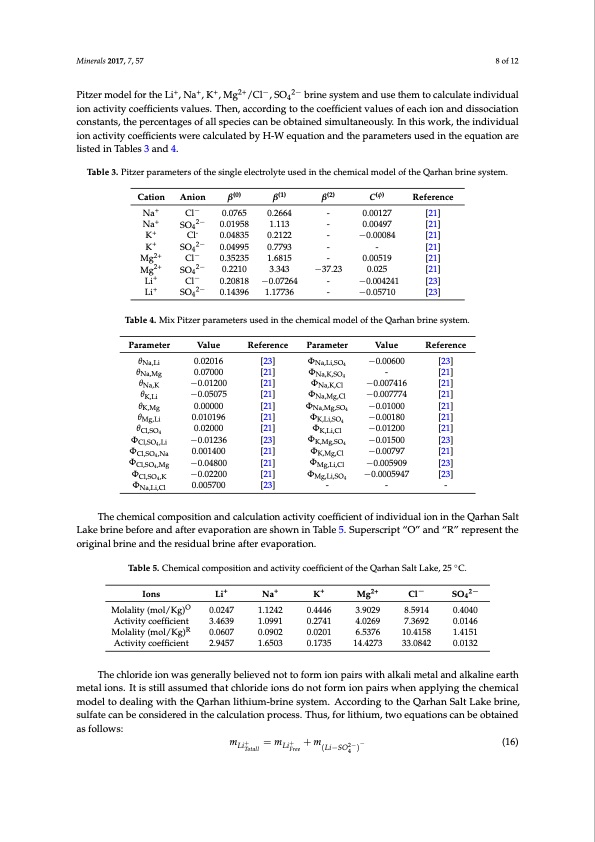
PDF Publication Title:
Text from PDF Page: 008
Minerals 2017, 7, 57 8 of 12 Pitzer model for the Li+, Na+, K+, Mg2+/Cl−, SO42− brine system and use them to calculate individual ion activity coefficients values. Then, according to the coefficient values of each ion and dissociation constants, the percentages of all species can be obtained simultaneously. In this work, the individual ion activity coefficients were calculated by H-W equation and the parameters used in the equation are listed in Tables 3 and 4. Table 3. Pitzer parameters of the single electrolyte used in the chemical model of the Qarhan brine system. Cation Na+ Na+ K+ K+ Mg2+ Mg2+ Li+ Li+ Anion Cl− SO4 2− Cl- SO4 2− Cl− SO4 2− Cl− SO4 2− β(0) 0.0765 0.01958 0.04835 0.04995 0.35235 0.2210 0.20818 0.14396 β(1) β(2) C(φ) 0.2664 - 0.00127 [21] 1.113 - 0.00497 [21] 0.2122 - −0.00084 [21] 0.7793 - - [21] 1.6815 - 0.00519 [21] 3.343 −37.23 0.025 [21] Reference −0.07264 - 1.17736 - −0.004241 [23] −0.05710 [23] Table 4. Mix Pitzer parameters used in the chemical model of the Qarhan brine system. Parameter θNa,Li θNa,Mg θNa,K θK,Li θK,Mg θMg,Li θCl,SO4 ΦCl,SO4 ,Li ΦCl,SO4 ,Na ΦCl,SO4 ,Mg ΦCl,SO4 ,K ΦNa,Li,Cl Value Reference 0.02016 [23] 0.07000 [21] −0.01200 [21] −0.05075 [21] 0.00000 [21] 0.010196 [21] 0.02000 [21] −0.01236 [23] 0.001400 [21] −0.04800 [21] −0.02200 [21] 0.005700 [23] Parameter ΦNa,Li,SO4 ΦNa,K,SO4 ΦNa,K,Cl ΦNa,Mg,Cl ΦNa,Mg,SO4 ΦK,Li,SO4 ΦK,Li,Cl ΦK,Mg,SO4 ΦK,Mg,Cl ΦMg,Li,Cl ΦMg,Li,SO4 Value Reference The chemical composition and calculation activity coefficient of individual ion in the Qarhan Salt Lake brine before and after evaporation are shown in Table 5. Superscript “O” and “R” represent the original brine and the residual brine after evaporation. Table 5. Chemical composition and activity coefficient of the Qarhan Salt Lake, 25 ◦C. −0.00600 [23] - [21] −0.007416 [21] −0.007774 [21] −0.01000 [21] −0.00180 [21] −0.01200 [21] −0.01500 [23] −0.00797 [21] −0.005909 [23] −0.0005947 [23] --- Ions Molality (mol/Kg)O Activity coefficient Molality (mol/Kg)R Activity coefficient Li+ Na+ 0.0247 1.1242 3.4639 1.0991 0.0607 0.0902 2.9457 1.6503 K+ 0.4446 0.2741 0.0201 0.1735 Mg2+ 3.9029 4.0269 6.5376 14.4273 Cl− 8.5914 7.3692 10.4158 33.0842 SO42− 0.4040 0.0146 1.4151 0.0132 The chloride ion was generally believed not to form ion pairs with alkali metal and alkaline earth metal ions. It is still assumed that chloride ions do not form ion pairs when applying the chemical model to dealing with the Qarhan lithium-brine system. According to the Qarhan Salt Lake brine, sulfate can be considered in the calculation process. Thus, for lithium, two equations can be obtained as follows: mLi+Totall = mLi+Free + m(Li−SO2−)− (16) 4PDF Image | Lithium during Brine Evaporation and KCl Production Plants

PDF Search Title:
Lithium during Brine Evaporation and KCl Production PlantsOriginal File Name Searched:
minerals-07-00057-v2.pdfDIY PDF Search: Google It | Yahoo | Bing
Product and Development Focus for Infinity Turbine
ORC Waste Heat Turbine and ORC System Build Plans: All turbine plans are $10,000 each. This allows you to build a system and then consider licensing for production after you have completed and tested a unit.Redox Flow Battery Technology: With the advent of the new USA tax credits for producing and selling batteries ($35/kW) we are focussing on a simple flow battery using shipping containers as the modular electrolyte storage units with tax credits up to $140,000 per system. Our main focus is on the salt battery. This battery can be used for both thermal and electrical storage applications. We call it the Cogeneration Battery or Cogen Battery. One project is converting salt (brine) based water conditioners to simultaneously produce power. In addition, there are many opportunities to extract Lithium from brine (salt lakes, groundwater, and producer water).Salt water or brine are huge sources for lithium. Most of the worlds lithium is acquired from a brine source. It's even in seawater in a low concentration. Brine is also a byproduct of huge powerplants, which can now use that as an electrolyte and a huge flow battery (which allows storage at the source).We welcome any business and equipment inquiries, as well as licensing our turbines for manufacturing.| CONTACT TEL: 608-238-6001 Email: greg@infinityturbine.com | RSS | AMP |